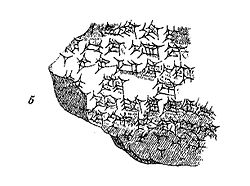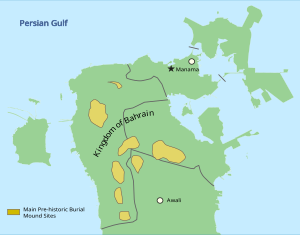迪尔蒙
 | |
| 地点 | 东阿拉伯 |
|---|---|
| 地区 | 今巴林北方省 |
| 类型 | 古代国家,文明 |
| 属于 | 东阿拉伯 |
| 历史 | |
| 建立于 | 约公元前4000年晚期[1] |
| 废弃于 | 约公元前538年 |
| 时代 | 青铜时代 |
| 系列条目 |
| 巴林历史 |
|---|
 |
| 远古 |
| 迪尔穆恩文化 |
| 阿瓦勒文化 |
| 卡尔马特派王朝 |
| 乌斯库里德王朝 |
| 乌尤尼德与贾尔万王朝 |
| 贾布里德王朝 |
|
|
| 穆克林·伊本·扎米尔 |
| 安东尼奥·科雷亚 |
|
|
| 1717年阿曼入侵巴林 |
|
|
| 巴尼欧特拜入侵巴林 |
| 和平友好永欠休战协定 |
| 巴林第一油井 |
| 民族联合委员会 |
| 巴林三月起义 |
|
|
| 巴林国家安全法 |
| 1990年代巴林起义 |
|
|
| 2011年巴林反政府示威 |
迪尔蒙(阿拉伯语:دلمون;苏美语:𒉌𒌇𒆠;希腊语:Týlos),或译为泰尔蒙[注 1],是一自公元前3000年开始广泛出现于美索不达米亚地区史书中的闪语国家,被认为是中东最古老的古文明之一[2][3]。根据书面记载,迪尔蒙位在波斯湾地区,座落于美索不达米亚与印度河流域文明间的贸易路线上,且邻近自流含水层[1][4]。
迪尔蒙曾是中东一重要的贸易中心;全盛时期的迪尔蒙甚至控制了波斯湾地区所有的贸易路线[1]。根据部分学者推测,苏美人视迪尔蒙为圣地[5],但此说法并未获得任何已知的古代记载支持。对美索不达米亚地区的文明而言,迪尔蒙是贸易伙伴与铜的产地,同时也是贸易转口港。目前学界普遍同意迪尔蒙位于今巴林、科威特[6]、卡达与沙特阿拉伯东部省沿海地区一带[7]。
历史
自公元前4000年晚期起至公元前800年为止,迪尔蒙一直是一重要的贸易中心[1],全盛时期的迪尔蒙控制了波斯湾地区所有的贸易路线[1][11]。公元前1000年至800年间迪尔蒙的商业力量开始因波斯湾海盗的猖獗而逐渐下滑。自公元前600年起,新巴比伦王国与稍后建立的波斯帝国相继征服了迪尔蒙。
迪尔蒙是传统农业地区与美鲁哈(位于印度河河谷)、马坎(位于今阿曼)以及美索不达米亚等地的贸易中心[3]。目前已知关于迪尔蒙文明的最早记载出自乌鲁克城伊南娜神庙出土的一块距今约5000年前的楔形文字泥板。在原始文献上,“迪尔蒙”这个词汇原先用以代指一种斧头与一位特定的官员[12]。除此之外,拉格什国王乌尔南塞(约公元前2500年在位)的一块门斗铭文上亦刻有迪尔蒙的相关记载,其内容为:“迪尔蒙的船只带来外地的木材做为贡品进献给他。”[13]。

尼普尔出土的布尔那布里亚什二世统治时期的两封信件亦提到了迪尔蒙。信件的撰写者是一位名为伊里伊帕希拉的迪尔蒙统治者,收信人为其朋友、尼普尔的统治者恩利尔基迪尼(Enlil-kidinni)。这两封信件与其他文件显示当时的迪尔蒙与加喜特王朝统治下的巴比伦维持着某种程度的交流。加喜特王朝覆灭后,除公元前1250年的亚述碑文外,美索不达米亚的文件便未再提及迪尔蒙;亚述的碑文记载亚述国王将会成为迪尔蒙与美鲁哈等地的王,同时记载了迪尔蒙向亚述进贡的情况。
公元前1000年左右的其他亚述碑文内容记载了亚述统治迪尔蒙的情形[14]。巴林境内的一处考古遗址显示亚述国王辛那赫里布曾侵略阿拉伯东北部,并占领了巴林所属的诸个岛屿[15]。关于迪尔蒙的最晚记载出自于新巴比伦王国统治时期。公元前567年的新巴比伦行政文书记载迪尔蒙被巴比伦国王所统治;公元前538年巴比伦覆灭后,迪尔蒙这个词汇即从此不复见于其他记载中[14]。
在印度古吉拉特邦洛塔、法伊拉卡岛与美索不达米亚等地发现的迪尔蒙通信文书是当时远距离海上贸易存在的有力证据,不过交易物内容就较难加以考证,可能包含木材、象牙、青金岩、黄金与其他如红玉髓等的奢侈品;波斯湾地区出产的珍珠、贝壳与镶嵌骨头饰品等则被运往美索不达米亚以换取银、锡、羊毛布料、橄榄油与谷麦等物资。另一方面,美索不达米亚与波斯湾地区则透过迪尔蒙以铜块与沥青等资源向印度河流域文明换取棉质布料与家禽等商品。以铜矿的挖掘与镕铸来说,今阿拉伯联合酋长国境内的乌姆纳尔遗址、大尔玛岛与阿曼境内的伊布里等地均是当时重要的生产地[16]。
部分来自美鲁哈的早期贸易船只可能会直接停靠美索不达米亚地区的港口以进行交易,但至伊辛-拉尔萨时期迪尔蒙便径行垄断了贸易路线。根据巴林国家博物馆的推断,迪尔蒙的“黄金时代”可能自公元前约2200年起一直持续至公元前约1600年止[17]。
民族、语言与宗教
迪尔蒙的构成民族可能为亚摩利人,使用苏美楔形文字进行记录[18],语言则可能为一种阿卡德语方言或近似于阿卡德语的语言[19][20]。迪尔蒙的主祀神祇为因萨克与其妻子帕尼帕[21]。
神话传说
苏美的早期史诗《恩美尔卡和阿拉塔之主》主要描述乌鲁克第一王朝的第二代国王恩美尔卡在乌鲁克与埃里都等地兴建金字形神塔的情形;根据史诗,恩美尔卡的兴建工程“始于迪尔蒙建立之前”。
迪尔蒙是部分苏美创世神话的设定背景,且常被形容为“太阳升起之地”或“生气盎然之地”,同时也是朱苏德拉等神话英雄升天并获得永生之地。丹麦历史学家索尔基德·雅各布森所翻译的埃里都创世传说将迪尔蒙称为“迪尔蒙山”,是个“遥远且半神话的地方”[22]。
恩基与宁胡尔萨格等神祇的创世传说亦有提及迪尔蒙,并将其描述为创世的发生地[9][23]。后期的巴比伦史诗《埃努玛·埃利什》描述迪尔蒙是代表咸水的神祇提阿玛特与代表淡水的神祇阿勃祖的相遇之地。在传说中,恩基向宁胡尔萨格承诺道:
在迪尔蒙,我妻心脏之地,我将创造长长的水道、河流与运河,水流经之处将解众生之渴,并为万物带来丰饶。
地点


1987年,美国考古学家泰瑞莎·霍华德-卡特(Theresa Howard-Carter)推测迪尔蒙可能位于阿拉伯河流域周边,确切地点可能介于今伊拉克南部市镇古尔奈与东南部城市巴士拉之间[24]。这个地点确实位于苏美的东方,符合苏美神话中迪尔蒙是太阳升起之地的描述。虽然诸多文献均对迪尔蒙有所描述,但截至2008年为止,考古学家仍未能找到任何迪尔蒙于公元前3300年至公元前556年间存在的证据。
伊甸园理论
1922年,奥地利考古学家艾德华·格拉瑟提出伊甸园位于东阿拉伯、迪尔蒙文明境内的理论[25]。德国学者尤利斯·萨林斯亦认为伊甸园就位于迪尔蒙境内底格里斯河与幼发拉底河汇流入海之处。根据此理论,《圣经》中所提及的基训河指的可能即是今伊朗境内的卡伦河;比逊河指的即是今已完全干涸的哈费尔巴廷河流系统[26]。
注释
参考文献
- ^ 1.0 1.1 1.2 1.3 1.4 Jesper Eidema, Flemming Højlundb. Trade or diplomacy? Assyria and Dilmun in the eighteenth century BC. World Archaeology. 1993, 24 (3): 441–448 [2017-09-19]. doi:10.1080/00438243.1993.9980218. (原始内容存档于2016-11-14).
- ^ Bahrain digs unveil one of oldest civilizations. BBC. [2017-09-19]. (原始内容存档于2014-11-13).
- ^ 3.0 3.1 Qal'at al-Bahrain – Ancient Harbour and Capital of Dilmun. UNESCO. [17 August 2011]. (原始内容存档于2018-12-25).
- ^ Dilmun and Its Gulf Neighbors. Harriet E. W. Crawford: 9. 1998.
- ^ Rice, Michael. Egypt's Making: The Origins of Ancient Egypt 5000-2000 BC. Routledge. 2004. ISBN 978-1-134-49263-3., page 230
- ^ The Invention of Cuneiform: Writing in Sumer. Jean-Jacques Glassner: 7. 1990.
- ^ Prehistory and Protohistory of the Arabian Peninsula: Bahrain. M. A. Nayeem: 32. 1990.
- ^ Edward Conklin. Getting Back Into the Garden of Eden. : 10 [2017-09-19]. (原始内容存档于2023-01-17).
- ^ 9.0 9.1 Kramer, Samuel Noah. Sumerian Mythology: A Study of Spiritual and Literary Achievement in the Third Millennium B.C.: Revised Edition. Philadelphia, Pennsylvania: University of Pennsylvania Press. 1961: 54–59 [21 May 2017]. ISBN 0-8122-1047-6. (原始内容存档于2020-08-08).
- ^ Kramer, Samuel Noah. The Sumerians: Their History, Culture, and Character. Chicago, Illinois: University of Chicago Press. 1963: 145-150 [21 May 2017]. ISBN 0-226-45238-7.
In fact, there is some reason to believe that the very idea of a paradise, a garden of the gods, originated with the Sumerians.
- ^ Dilmun and Its Gulf Neighbours. Harriet E. W. Crawford: 152. 1998.
- ^ Crawford, Harriet E. W. Dilmun and its Gulf neighbours. Cambridge: Cambridge University Press. 1998: 5. ISBN 0-521-58348-9.
- ^ Samuel Noah Kramer. The Sumerians: their history, culture, and character. 1963: 308.
- ^ 14.0 14.1 Larson, Curtis E. Life and land use on the Bahrain Islands: The geoarcheology of an ancient society. Chicago: University of Chicago Press. 1983: 50–51. ISBN 0-226-46905-0.
- ^ Mojtahed-Zadeh, Pirouz. Security and Territoriality in the Persian Gulf: A Maritime Political Geography. Richmond, Surrey: Curzon. 1999. ISBN 0-7007-1098-1.
- ^ Egypt's Making: The Origins of Ancient Egypt 5000–2000 BC. Michael Rice: 229. 1991.
- ^ The UK Register, Science, Lost ancient civilisation's ruins lie beneath Gulf, By Lewis Page Science, December 9, 2010. [2017-09-19]. (原始内容存档于2017-11-07).
- ^ William H. Stiebing Jr. Ancient Near Eastern History and Culture. 2016: 217. ISBN 9781315511153.
- ^ Jean Jacques Glassner. Dilmun, Magan and Meluhha. Julian Reade (编). The Indian Ocean In Antiquity. 2013-10-28: 242. ISBN 9781136155314.
- ^ Serge Cleuziou. The emergence of oasis towns in eastern and southern Arabia. G. Afanas'ev; S. Cleuziou; R. Lukacs; M. Tosi (编). The prehistory of Asia and Oceania, Forlí: Colloquia of the XIII International congress of prehistoric and protohistoric sciences 16. ABACO Edizioni, Forlì. 1996: 157. ISBN 978-88-86-71206-4.
- ^ Jean Jacques Glassner. Dilmun, Magan and Meluhha. Julian Reade (编). The Indian Ocean In Antiquity. 2013-10-28: 239. ISBN 9781136155314.
- ^ Thorkild Jacobsen. The Harps that once--: Sumerian poetry in translation. Yale University Press. 23 September 1997: 150 [2 July 2011]. ISBN 978-0-300-07278-5.
- ^ Kramer, Samuel Noah. The Sumerians: Their History, Culture, and Character. Chicago, Illinois: University of Chicago Press. 1963: 145-150 [21 May 2017]. ISBN 0-226-45238-7.
- ^ Howard-Carter, Theresa. Dilmun: At Sea or Not at Sea? A Review Article. Journal of Cuneiform Studies. 1987, 39 (1): 54–117. JSTOR 1359986. doi:10.2307/1359986.
- ^ W. F. Albright. The Location of the Garden of Eden. The American Journal of Semitic Languages and Literatures. October 1922, 39 (1): 15–31. JSTOR 528684. doi:10.1086/369964.
- ^ Hamblin, Dora Jane. Has the Garden of Eden been located at last? (PDF). Smithsonian Magazine. May 1987, 18 (2) [8 January 2014]. (原始内容 (PDF)存档于9 January 2014).
外部链接
- Indus Valley—Mesopotamian trade passing through Dilmun
- Lost ancient civilisation's ruins lie beneath Gulf, says boffin (页面存档备份,存于互联网档案馆)
- Bahrain National Museum's hall of Dilmun
- Dilmun Site Al-Khidr, Failaka Island, State of Kuwait (页面存档备份,存于互联网档案馆)
- Greek inscriptions found on Bahrein (a pdf-file)[永久失效链接]
- Dilmun Calendar Theory Backed, Gulf Daily News, 11 July 2006
| |||||||||||||||||||||||||||||||||||||||||||||||||
Text is available under the CC BY-SA 4.0 license; additional terms may apply.
Images, videos and audio are available under their respective licenses.
